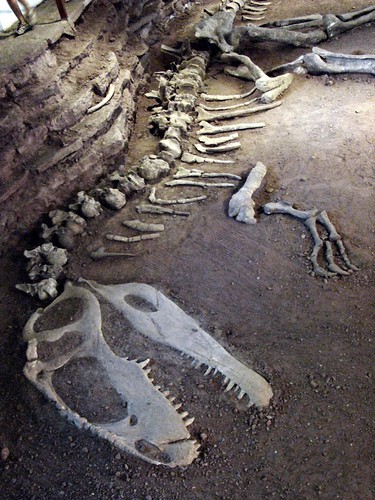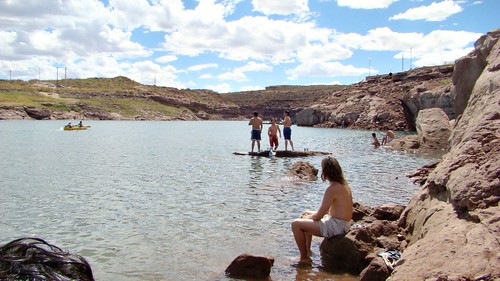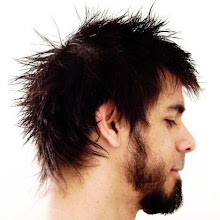The day after we arrived in Neuquén, we took a little Cono Sur bus to Villa El Chocón, a town beside the Ezequiel Ramos Mexía reservoir, best known as simply El Chocón, which is the name of the dam rather than the lake. El Chocón is a dam on the Limay River, with a 1,200 MW hydroelectric power plant, the largest in Patagonia.
We had two reasons to go there: one, Villa El Chocón has a paleontogical museum, with a small sample of fossils, the star being a reconstruction of Giganotosaurus carolinii, found in Neuquén and advertised as "the largest terrestrial carnivore in the history of Earth", though the more recently found Spinosaurus now seems to bear that title.
The second reason was the reservoir itself. The lake is an impressive sight, so much emerald water in an otherwise arid landscape, and man-made on top of that. We had to walk a couple of kilometers along the shore, and we came to the "beach resort", which is just an expression because there was no beach, properly speaking, on our side; you just had to climb down the rocks, three or four meters, until you got near the water, and pick a spot where you could leave your stuff.
It was now really hot, at 3 PM in the sun, surrounded by all that rock and sand, so after a short while we all got into the water, which was (no kidding) just above freezing point — remember these are the waters of a river that flows from thawing ice up in the Andes.
I'm no good at swimming and I feared a could get cramps from the cold, but I took the plunge and then followed the coast, stopping from time to time to test the rocks at the bottom and enjoy the cool. When I looked back, my two friends were waving at me from the other side of our branch of the lake, maybe 100 meters away. Being more-or-less in shape, they swam back quickly, though they complained that the cold water made their ears hurt.
We climbed up to the road after a while, and sat on a bar with a couple of beers. We had plenty time before the last bus came, so we walked along the shore of the reservoir until we could see the dam.

Then we came back and sat on the bus stop. We had bought our return tickets in advance, but there were many other people there who hadn't, so when the bus came, we got in and took our seats first, and the driver waited until the bus was full, and left.
The trip was hellish. The bus was packed, it was hot (around 30 degrees I guess), there was no air conditioning, and the windows were jammed. And this was no short trip; it was 82 km and took an hour and a half on a road that was, mercifully, in good condition.

That night we got our bags ready, and got prepared to leave for Junín de los Andes, our next stop, early in the morning.















No comments:
Post a Comment
Note: Only a member of this blog may post a comment.